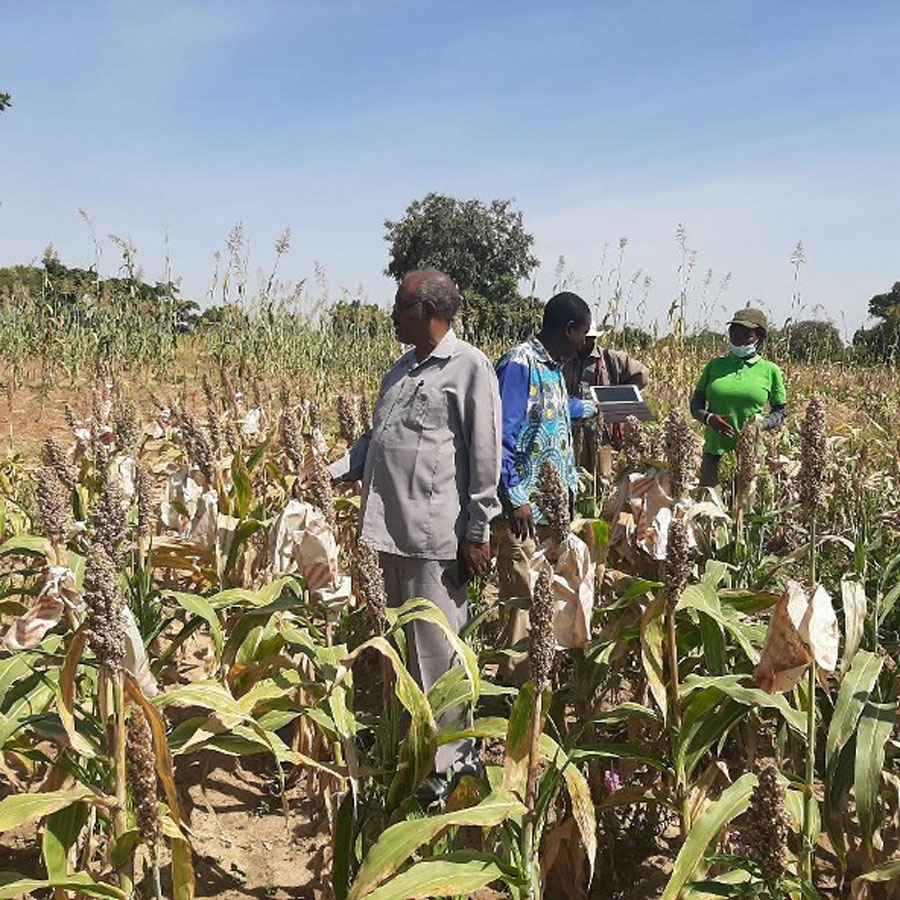Striga hermonthica, commonly known as witchweed, is a dangerous enemy of food security, which makes it the enemy of Philippe Nikiema, a plant breeder at the Institute of Environment and Agriculture Research (INERA) in Burkina Faso.
A parasite, Striga can’t exist without a host plant, and too often its preferred host is sorghum, a staple crop for millions throughout the world. It also attacks millet. Striga poses a great threat to agriculture globally. “Striga is the major and most persistent biotic threat to the production of these crops mostly grown on the hottest and driest marginal regions of sub-Saharan Africa, the Middle East, and large parts of Asia,” Nikiema told Grow Further in an interview. In a grant application Nikiema and his team recently submitted to us for consideration, they describe a research project to test witchweed-resistant sorghum on farms throughout Burkina Faso, West Africa, and beyond. The tool used to develop the witchweed-resistant sorghum is a rather interesting one: gamma radiation.
“We have identified three mutant lines that are resistant to Striga hermonthica.”
In the Marvel comic book The Incredible Hulk, scientist Bruce Banner becomes a giant, bullet-proof green monster through a mutation caused by accidental exposure to gamma rays. With the help of the International Atomic Energy Agency (IAEA), Nikiema and his colleagues are very deliberately exposing sorghum seeds to gamma radiation in the hope of causing those seeds to mutate as well, only they aim to produce mutations that make these plants Striga-proof.
And as Nikiema explained to us, they are closing in on that goal. “We have identified three mutant lines that are resistant to Striga hermonthica,” he told us. Two of these lines seem to hold particular promise. The desired mutations appear to lead sorghum plants to develop a “mechanical barrier” that keeps Striga’s parasitic roots and their nutrient-draining haustorium from attaching, he explained. “One sorghum mutant, B4, resistant to Striga showed the inability of Striga haustoria to attach to sorghum roots with weak haustoria formation after germination of Striga seeds.”
There are other ways to control witchweed infestations without resorting to mutation-inducing gamma rays, Nikiema acknowledged. “Crop rotation and the use of false hosts, fertilization and the use of chemical compounds to reduce Striga seed bank, cultural methods, and biological control,” he listed off. “However,” Nikiema continued, “none of these options individually show full effectiveness. Furthermore, most of these techniques are applied when at least 75% of the damage caused by Striga has already occurred during its underground development phase.” In other words, traditional intervention usually occurs after much of the damage has already been done. Striga hermonthica infestations begin underground and out of sight.
Traditional control methods can also be expensive and are often beyond the reach of impoverished smallholder farmers, the very same farmers Nikiema hopes to help through his research efforts. “The use of fertilizers requires financial means that are not always accessible to small farmers,” he said. “Herbicides are not widely used because of their high costs and their negative impact on biodiversity. Also, the intensive use of herbicides can lead to the development of herbicide-resistant plants, environmental contamination, adverse effects on non-target organisms, soil and water pollution.” All these negative side effects could be avoided if the planted sorghum was bred to resist witchweed attacks at the outset.
Nikiema hopes to launch field testing of at least three potentially Striga-resistant sorghum varieties to determine which line holds the most promise. Through field testing, data collection, and further laboratory analysis Nikiema and colleagues seem confident that they can identify and reproduce a new type of sorghum to help feed the future.
The incorporation of gamma radiation makes the entire project sound rather complex, but Nikiema assured us that this innovation will ultimately prove safe and simple for smallholder sorghum farmers to embrace. “Biological control requires special technical skills and an investment in human and financial resources,” he explained. “Genetic control, which is what we are promoting, uses varietal resistance to control Striga. It has no effect on the environment, is easy for farmers to adopt because it does not require any particular technical skills, and the price of the seeds of improved varieties is subsidized in Burkina Faso to allow the greatest number of producers to have access to them.”
Regulators agree that the technique is safe, and mutation breeding is not only approved but also consistent with organic labeling worldwide.
— Grow Further
Photo credit: An inspector from the IAEA joins researchers in a Striga hermonthica-infected field to examine how mutated lines of sorghum are holding up to the attack. Philippe Nikiema, INERA.




